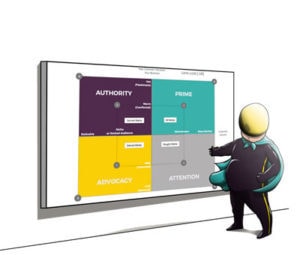
Contrary to what you might automatically think, the technology industry is not immune to disruption and technology companies are not necessarily best placed to win in the digital world.
Value Added Resellers (VARs) purchase products from manufacturers and wrap additional services around the technology. It’s with these additional services that VARs have been delivering value so this is naturally where their focus has always been – becoming expert in how to use these products making the lives of their customers easier and helping them to implement and service the technology solutions they need.
The VAR market is currently being disrupted. We’re seeing:
– A rise in public cloud. Private cloud is the VAR domain. Public cloud makes it dramatically quicker to move from idea to realisation. In reality, this means that customers can have a first draft solution in place and working long before a VAR could have private cloud infrastructure solution specified, ordered and installed on premise.
– Consolidation is one of the hallmarks of an industry past its peak. We’re seeing increasing commoditisation throughout the technology industry. More and more we’re seeing out of the box solutions take the place of bespoke solutions; websites, software, digital solutions are all increasingly available, accessible, cost effective and ready to use straight away.
– Change in the VAR/vendor relationship. We’re seeing more vendors going direct to the end user, thereby cutting out the VARs altogether.
– A decline in demand for the traditional wrap-around services offered by VARs.
– Demand for ‘Managed Services’ has dropped by 35% since 2012
– Demand for ‘IT Solutions’ has dropped by 50% since 2013
Demand for ‘Networking’ has dropped by 60% since 2013
– Demand for ‘IT Provider’ has dropped by 60% since 2012.
– Demand for ‘IT Security’ hasn’t changed since 2012
What’s going on?
Disruption in any industry happens when new more effective, affordable and convenient alternatives come into the marketplace. As customers start to adopt these new solutions, these new businesses start to nibble away at the profits and marketshare of the larger incumbents or prime players.

The Ionology Digital Marketplace Quadrant
In the digital landscape the small number of prime players in any given market are the ones who get the lion’s share of the goods. They have the highest brand recognition and customer loyalty. They get most of the profits, most of the customers and most of the glory. Being in prime position is clearly the most covetable position in the marketplace but is not easily achieved and for those who do make it, they have to constantly defend their position from attack. Everyone has their eyes on the top spot!
The companies that they need to defend themselves against are the ones with cash who are spending small fortunes on advertising (companies in Attention in the bottom right of the quadrant) and those who are attacking from the left side – the Authority players who have reached their desirous position because of their innovations. These innovations are starting to change the game; they are being talked about by industry experts and changing people’s lives sufficiently for consumers to talk about them.
Prime players must make a choice – innovate themselves, acquire their competitors or lose market share and shrink.
In the case of the VAR industry, the innovations are coming thick and fast and the marketplace is changing at a very fundamental level. The rise of public cloud is changing the game completely as customers are increasingly making the choice to move to public cloud as a more effective, efficient and convenient solution for storing and sharing data.
The role of technology in the digital age.
Strategy creates competitive advantage.
People and a culture of innovation sustains it.
Technology and communications are the means by which it is delivered.
In other words, technology is the delivery agent and not the message. It’s the syringe rather than the medicine, it’s the courier service rather than the package. We all have plumbing in our homes – boilers, radiators, pipes and thermostats. Nobody really wants a boiler; we just want the ability to heat our homes and have access to warm water in the most efficient way possible. Now we can even operate our thermostats from our mobile phones which is a relatively new innovation many people are adopting but if a new invention came onto the market that delivered the heating capabilities we require in a more effective, affordable and convenient manner we’d happily ditch our boilers and adopt the new technology.
This is the change that must be made by VARs and indeed anyone who wants to win in the digital age. It’s an upgrade in thinking – not an upgrade in technology. The game has changed.
The real technology upgrade
It’s an upgrade in thinking that delivers the latest innovations in technology. It means making the shift to the kind of thinking that will deliver competitive advantage in the digital age. The benefits for those who succeed in making this shift can be huge. Not only do transformed businesses win by creating competitive advantage and fuelling growth but their partners and most of all their customers. These are the kinds of innovations that build trust, brand equity and engender customer loyalty and long term, mutually beneficial relationships.
Technology has tremendous power to change our world but the investigative and creative work that precedes the design, development and implementation is critical.
If we take a look at the 7 Principles of Digital Business Strategy framework, we see that Know Your Customer is one of those 7 principles. Within this principle, there are 3 constituent parts: Volume, Task and Intent.
These are crucial components that need to be understood. From a business perspective, we need to know our customer volume to assess the size of the opportunity available to us and to understand the size of our potential customer base. Does it make good sense to create a strategy around servicing this population? Are there enough people looking for our product or service to sustain our business or fulfil our ambitions?
Even more importantly are Task and Intent and this is where digital businesses are winning. Understanding the jobs or tasks of our customers and their parameters around these is essential. Once we know what our customer’s jobs are and what their intention is we can start to work on our value propositions and products. How can we help our customers to do their jobs better and if we do create solutions does it match with the intention or motivation of our customers?
Spotify, Airbnb and Uber are all widely cited examples of digital businesses that have created serious disruption in their prospective marketplaces. Each uses technology to deliver their services and products but the reason they have all been so successful is not because of their websites or apps but because they are helping their customers perform their tasks in a more affordable, effective and convenient manner than their competitors. Their winning formula has been to understand their customers’ tasks and intentions and find way to meet that need. Spotify gives people access to music they want to listen to without having to buy albums. Airbnb helps people find somewhere to stay when they travel and don’t want a hotel. They also help hosts make some money from renting out spare rooms. Uber helps people get from A to B with all the speed and efficiency of a taxi or private car but makes it even more affordable and convenient.
This is the space that the winners in the VAR marketplace are moving into.
Interestingly, it doesn’t have to be technology companies who fulfil this need. The traditional management consultancies are taking a share of this marketplace because they are used to this kind of thinking. They work alongside senior management, they solve business problems, they reimagine and redesign. Now that the technology component is becoming more accessible they can easily diagnose the problems and implement the solutions without needing to be technical geniuses.
Technology companies and VARs in particular can start moving into this space by adopting the kind of thinking that leads to digital transformation.
Where to start?
Step one is to develop the language, tools and thinking that can diagnose business challenges. Step two is to develop the techniques that bring insights into customer behaviour and help us to understand what it is that they want to do or achieve and how they wish to go about it. Step three is the part that comes naturally to our technical whizzes – develop the solutions that will help. These solutions may require innovation, creation, co-creation or simple implementation and VARs need to be ready to make the right recommendations for their customers no matter what form they may take.
The shape of the VAR industry is definitely changing and there are options to be considered and choices to be made. Further consolidation is one such option – consolidate to create further efficiencies of scale and to gain customers. The alternative it is to start developing the company’s ability to deliver digital transformation projects to their customers and move into this strategic space. This can happen hand in hand with business as usual, becoming another string to their bows.
It would mean a different kind of relationship with the customer’s executive team.
It would mean adopting a different mindset when it comes to technology design and development.
It would also mean developing new skills and techniques for uncovering the critical business issues and for understanding customers, their needs, their behaviours and the values and drivers hiding behind those tasks and jobs.
The rewards could be substantial.
The future is yet to be written, but the competition for authors is now on.
To read more about our Digital Transformation frameworks click here.
To learn more about our partner programmes for businesses wishing to learn our frameworks and techniques for delivering Digital Transformation click here.
For free online Digital Transformation training click here.


